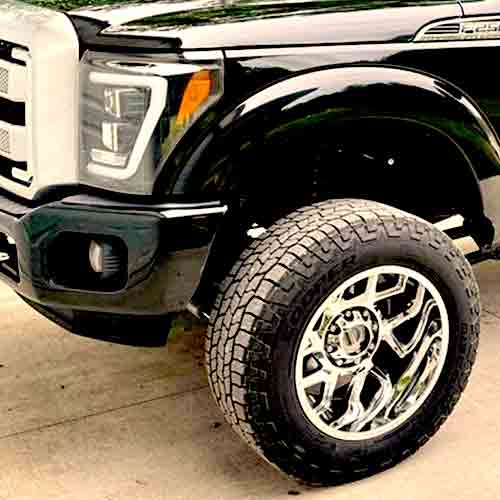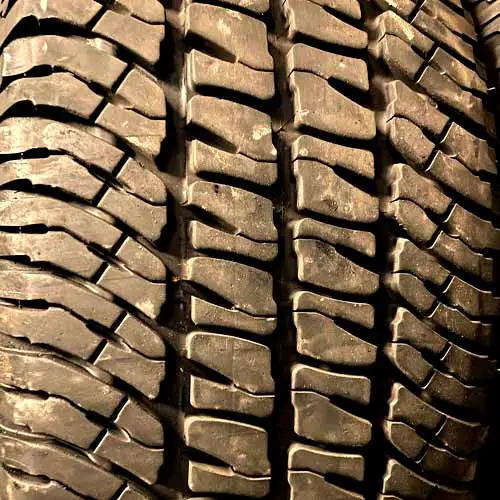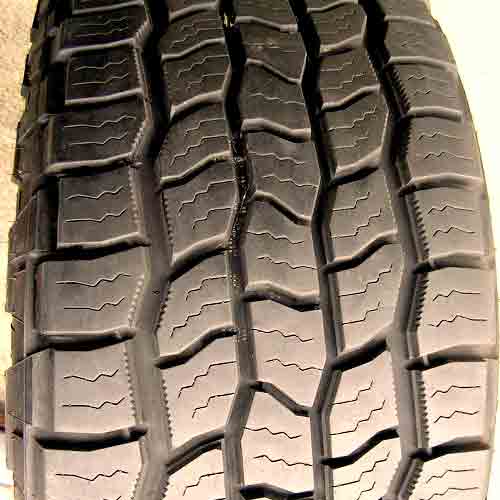Both the Cooper Discoverer AT3 and the Michelin LTX AT2 are packed with innovative tread compositions that yield a superb balance of traction and comfort. They are perfect for light trucks and full-sized SUVs. Let’s take a closer look to see which one will bring you a more favorable experience.

In my expert opinion as a tire engineer, the Cooper Discoverer AT3 yields better performance in wet (highways/pavements), the comfort department, and nearly all off-road areas. Whereas the Michelin LTX AT2 performs better in terms of dry grip and fuel economy. And yes, both tires have similar tread life and winter traction.
Info on Sizes
The Michelin LTX AT2 comes in just 20 limited sizes in 15 to 20 inches, with following specs.
- Speed ratings: R, S and T
- Load ratings: SL, XL, C, D and E
- Tread depth: 14 to 17/32″
- Weight range: 32 to 60 lbs
- Not rated with 3PMSF
- 60k miles warranty on all sizes
Detailed review of this tire: https://tiredriver.com/michelin-ltx-at2-review/
On the other side, the Cooper Discoverer AT3 XLT, with 32 sizes in 15 to 20 inches, has the following specs:
- Speed ratings: R or S
- Load ratings: C to F
- Weight range: 44 lbs to 70 lbs
- Tread depth is seen to be either 16.5 or 17/32″ in all sizes
- All sizes have 60k miles warranty
Detailed Review of Cooper AT3 XLT: https://tiredriver.com/cooper-discoverer-at3-review/
Tread Pattern
The Michelin LTX AT2 gives you a very biting tread.

Let me discuss its central section first.
The middle part has 3 main ribs where blocks are pasted on a continuous secondary rubber layer.
These layers act as reinforced foundational supports and provide the tire with superb on-road stability.
With them, lugs get to have restricted movement which enhances the overall steering response.
Moreover, the full depth sipes and biters (in-groove notches) also offer the needed off-road grip as well.
The shoulder lugs are much bigger, or should I say elongated.
They have X-shaped sipes on them with notches, and supporting foundations (just like seen on the blocks in the middle).
Though its sides are still less aggressive compared to its counterpart, as they don’t form any sidewall lugs.
In comparison, the Cooper AT3 may have a less aggressive middle area, its sides are pretty biting.

The shoulder lugs are staggered and form thicker sidewall lugs in comparison.
Actually, there are 3 variants of this tire, 4S, LT, and XLT, and out of all, the XLT has the chunkiest sidewalls of all.
Review 4S variant here: https://tiredriver.com/cooper-at3-4s-review/
The serrated edges (of shoulders) basically act as mud scoops and offer traction on mild muddy trails, whereas the sidewall lugs enhance the footprint with lowered air pressure providing climbing capabilities (especially), on rocks and sandy dunes.
In the middle, the tire offers 3 ribs, of squared-off-like blocks, where the central most rib is the widest (this provides on-road stability and traction).
These blocks have off-set edges, reinforced foundations, and full-depth wave-like siping.
Moreover, the outer two ribs (separated from shoulders with wider circumferential grooves), also offer snow vices, along with the rest of the features as well.
Dry Roads Capabilities
The dry performance of an all-terrain tire is characterized by traction, steering, and cornering ability. Let’s delve deeper into these critical components.
Dry Handling
The weight transfer to the shoulders during cornering highlights the crucial role of the outer rib’s contact with the ground in determining a tire’s lateral traction and handling.
That’s why with a harder compound, lighter weight, and greater rubber to road contact, you see superior results on Michelin LTX AT2.
The stiffer tread composition and lighter weight resist the lugs from moving/bending a lot as the tire corners, providing stability, and the greater rubber to road contact yields greater rolling resistance.
Both of these factors not only improve handling capabilities but also the overall steering sensitivity.
The Cooper Discoverer AT3, on the other side, lacks because its shoulder lugs aren’t that elongated, and its softer compound forces its blocks to flex more, limiting steering feedback.
Directional Grip
The traction of a tire on a straight road is referred to as dry or directional grip, but why straight? Well, because it gets measured with braking distances and acceleration times, and both of these metrics are directional.
Having said that, out of both tires, you get better efficacy on Michelin LTX AT2. The tire offers more biters, and its lugs are more streamlined, longitudinally. Both of these factors allow the tire to have quicker stopping abilities.
The Cooper AT3, on the other side, besides having wider grooves, takes longer to stop, where its heavier weight also adds to that (as it creates greater moving inertia).
Wet Grip
When it comes to wet traction, there’s only one thing to worry about, and that’s water removal capabilities.
But how does a tire clear water off from its tread? Well, the majority of the water leaves the tire from the tread voids, and since all-terrain tires are bald enough, hydroplaning is not a big issue with them. But the little (left-over) water that comes directly in contact with the lugs has to be cleared off with sipes.
Sipes are slits that flex to provide a vacuum, absorbing water particles in, and the Cooper AT3 with more of these (sipes) supplies better wet grip, or you can say, clearing of the water at a micro-level.
The Michelin LTX AT2, on the other side, has a stiffer compound, and sipes aren’t able to breathe water as effectively, compared to Cooper.
Snow Traction
Although the Michelin LTX AT2 is not 3 peak mountain snowflake rated (like its competitor), it shows pretty great traction abilities, still.
The 3PMSF rating does not tell you about the overall snow performance, it just tells you that the tire is better in accelerating (on snowy pavements), compared to average all-season tires.
That’s why although the Cooper Discoverer AT3 provides better acceleration abilities, its overall handling is almost on par with its counterpart.
For winter traction, you need snow grabbing abilities, and with numerous notches (combined with sipes), on Michelin LTX A/T2, the tire yields amazing snow-to-snow contact.
So overall, you can’t put one tire over the other here.
Fuel Economy
The weight and tread structure of the tire are vital determinants of rolling resistance, which then affects fuel usage. Having said that, the Michelin LTX AT2, with a lighter structure and a stiffer tread compound, becomes more fuel-efficient in comparison.
This is due to its lugs not flexing as much, which reduces energy waste.
When a tire corners, for example, the lugs would want to bend in the opposite direction (of that corner), and on Michelin’s model, the continuous running ribs, combined with its more rigid tread composition, cause the blocks to bend less, and the energy channels better into the rolling of the tire.
The Cooper Discoverer AT3, on the other hand, having a softer compound and greater weight, does the opposite, so it’s not able to come out with as much fuel efficacy as its counterpart.
Tire’s Toughness
When it comes to a tire’s toughness, there are a lot of things to consider, from tread pattern to its composition, as well as internal build (where mostly sidewalls are the main focus).
Considering all these factors, I rate the Cooper AT3 better out of the two (speaking from experience and real-life testing).
Both tires give you a 2-ply polyester casing covered with 2 steel belts, and even though on top of that, you get an extra cap ply on Michelin LTX AT2, it’s not going to make too much of a difference, as it’s not on sidewalls.
Whereas, the Cooper Discoverer AT3 with thicker lugs there better protects the tire out of the two, being more puncture-resistant on the sidewalls.
Traction on Mud
In mud, all-terrains mostly struggle, and this especially goes for these two tires over here, with their on-road oriented structure, though out of them, you are still better off with Cooper Discoverer AT3.
This is because the tire has a more open tread design in comparison, and its thicker sidewall lugs and staggered shoulders account for better mud scooping and paddling abilities.
The Michelin LTX AT2, on the other hand, lacks severely here, with its continuous running longitudinal ribs disallowing thick mud to escape out laterally.
Moreover, its missing sidewalls and serrated edges aren’t helping the tire’s traction either.
Sand Performance
For grip on sand, it’s necessary to reduce the tire’s air pressure, otherwise it might not be able to float properly. This goes for both deeper, as well as lighter terrains.
Side Note: Make sure you check my guide on air pressure for off-road tires.
On loose surfaces like sand, digging is your worst enemy, and so that’s why the Michelin LTX AT2 with a harder compound and sharper shoulder edges tends to lack here, relatively.
Whereas the Cooper Discoverer AT3 yields superior traction mostly due to its sidewall lugs which get to spread out with lowered air pressure, enhancing the tire’s overall footprint and section width.
Rock Climbing
On rocks, you need two main things:
- Biters, which are capable of gripping towards multiple directions.
- And solid sidewalls, with stronger inner construction, and thick enough lugs, outside.
That’s why the Michelin LTX AT2, although features a lot of notches and biters, again lacks here with its limited sidewalls.
These sides not only protect the weakest part of the tire on Cooper AT3 but also effectively grab and pull onto the rocky surface, when you (especially) run the tire with lowered air pressure.
Ride Comfort
Being a stiffer tire, the Michelin LTX AT2 is not able to provide as much comfort, as imperfections of the roads aren’t absorbed by its tread in a better way. Whereas the Cooper Discoverer AT3 with its softer compound does a better job.
Furthermore, Cooper also features Whisper Grooves Technology, with which it places connectors between the shoulder lugs.
These offer stability on the road, as they act as reinforced foundations, and at the same time, also stop too much air from coming in and hitting the walls of the tread, which generates noise (providing a quieter ride, as a result).
So overall, I am rating this tire to be more comfortable out of the two.
Summary
So overall, it all comes down to this.
The Cooper Discoverer AT3 is better in wet, comfort, and off-road conditions.
Whereas the Michelin LTX AT2 comes better in terms of dry grip and fuel economy. Both tires have similar tread life and winter traction.
My Michelin ltx tires cracked all over to the point of being dangerous at just 17,000 miles and had to be replaced by Michelin with BFG ko2 tires . They prorated them and made me pick another of their tire brands . The ko2’s are pretty work out at 39,000 miles. Tried twice with Michelin going somewhere else for tires for my 9 vehicles from now on. Probably Cooper or Goodyear from now own. Very disappointed in the number one tire maker for sure.